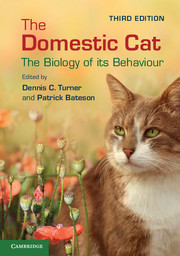Book contents
- Frontmatter
- Contents
- Contributors
- Abbreviations
- I Introduction
- II From Kitten- to Adulthood
- III Social Life and Ecology
- IV Cats and People
- V Cat Breeding and Cat Welfare
- 10 Feline welfare issues
- 11 Breed and gender behaviour differences: relation to the ancient history and origin of the domestic cat
- 12 Showing cats
- 13 Individual and environmental effects on health and welfare
- 14 Feline behavioural problems and solutions
- VI The Future
- References
- Index
13 - Individual and environmental effects on health and welfare
Published online by Cambridge University Press: 05 December 2013
- Frontmatter
- Contents
- Contributors
- Abbreviations
- I Introduction
- II From Kitten- to Adulthood
- III Social Life and Ecology
- IV Cats and People
- V Cat Breeding and Cat Welfare
- 10 Feline welfare issues
- 11 Breed and gender behaviour differences: relation to the ancient history and origin of the domestic cat
- 12 Showing cats
- 13 Individual and environmental effects on health and welfare
- 14 Feline behavioural problems and solutions
- VI The Future
- References
- Index
Summary
Introduction
Individual states of health and welfare result from complex interactions between the individual and the environment it inhabits. Recent research has resulted in a paradigm shift in our understanding of these relationships, with identification of new individual vulnerability factors that change disease risk, the effects of inhabiting environments far removed from the animal’s natural history, and the central role of the interaction between humans and animals on the welfare of each.
This chapter will describe some of these issues from the perspective of domestic cat health and disease. Beyond the implications for cat health and welfare, how these factors influence cats also serves as an example of factors affecting health and disease in other species, with the cat serving as the ‘canary in the coal mine’. Environmental factors affecting cat behaviour and welfare in confinement, in homes, or in cages while housed in shelters, research facilities and veterinary clinics and how to optimise the environment by minimising perceived threat through provision of resources, control and predictability will be outlined.
- Type
- Chapter
- Information
- The Domestic CatThe Biology of its Behaviour, pp. 185 - 200Publisher: Cambridge University PressPrint publication year: 2013
- 3
- Cited by

